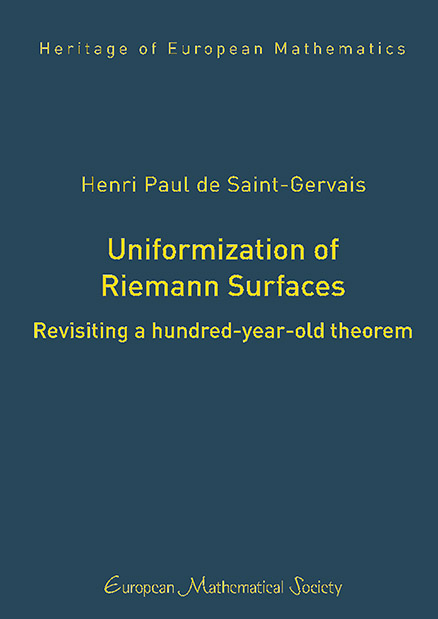
Uniformization of Riemann Surfaces
Revisiting a hundred-year-old theorem
Seiten
2016
EMS Press (Verlag)
978-3-03719-145-3 (ISBN)
EMS Press (Verlag)
978-3-03719-145-3 (ISBN)
- Titel z.Zt. nicht lieferbar
- Versandkostenfrei
- Auch auf Rechnung
- Artikel merken
In 1907 Paul Koebe and Henri Poincaré almost simultaneously proved the uniformization theorem: Every simply connected Riemann surface is isomorphic to the plane, the open unit disc, or the sphere.
It took a whole century to get to the point of stating this theorem and providing a convincing proof of it, relying as it did on prior work of Gauss, Riemann, Schwarz, Klein, Poincaré, and Koebe, among others. The present book offers an overview of the maturation process of this theorem.
The evolution of the uniformization theorem took place in parallel with the emergence of modern algebraic geometry, the creation of complex analysis, the first stirrings of functional analysis, and with the flowering of the theory of differential equations and the birth of topology. The uniformization theorem was thus one of the lightning rods of 19th century mathematics. Rather than describe the history of a single theorem, our aim is to return to the original proofs, to look at these through the eyes of modern mathematicians, to enquire as to their correctness, and to attempt to make them rigorous while respecting insofar as possible the state of mathematical knowledge at the time, or, if this should prove impossible, then using modern mathematical tools not available to their authors.
This book will be useful to today's mathematicians wishing to cast a glance back at the history of their discipline. It should also provide graduate students with a non-standard approach to concepts of great importance for modern research.
It took a whole century to get to the point of stating this theorem and providing a convincing proof of it, relying as it did on prior work of Gauss, Riemann, Schwarz, Klein, Poincaré, and Koebe, among others. The present book offers an overview of the maturation process of this theorem.
The evolution of the uniformization theorem took place in parallel with the emergence of modern algebraic geometry, the creation of complex analysis, the first stirrings of functional analysis, and with the flowering of the theory of differential equations and the birth of topology. The uniformization theorem was thus one of the lightning rods of 19th century mathematics. Rather than describe the history of a single theorem, our aim is to return to the original proofs, to look at these through the eyes of modern mathematicians, to enquire as to their correctness, and to attempt to make them rigorous while respecting insofar as possible the state of mathematical knowledge at the time, or, if this should prove impossible, then using modern mathematical tools not available to their authors.
This book will be useful to today's mathematicians wishing to cast a glance back at the history of their discipline. It should also provide graduate students with a non-standard approach to concepts of great importance for modern research.
| Erscheinungsdatum | 01.02.2016 |
|---|---|
| Reihe/Serie | Heritage of European Mathematics |
| Sprache | englisch |
| Original-Titel | Uniformisation des surfaces Riemann |
| Maße | 170 x 240 mm |
| Einbandart | gebunden |
| Themenwelt | Mathematik / Informatik ► Mathematik ► Analysis |
| Mathematik / Informatik ► Mathematik ► Geschichte der Mathematik | |
| Schlagworte | continuity method • Fuchsian Groups • GAUSS • klein • Koebe • Poincaré • Riemann • Riemann Surfaces • Schwarz • uniformization |
| ISBN-10 | 3-03719-145-7 / 3037191457 |
| ISBN-13 | 978-3-03719-145-3 / 9783037191453 |
| Zustand | Neuware |
| Haben Sie eine Frage zum Produkt? |
Mehr entdecken
aus dem Bereich
aus dem Bereich
Band 5: Hydraulik, Stromfadentheorie, Wellentheorie, Gasdynamik
Buch | Softcover (2024)
De Gruyter Oldenbourg (Verlag)
CHF 83,90


